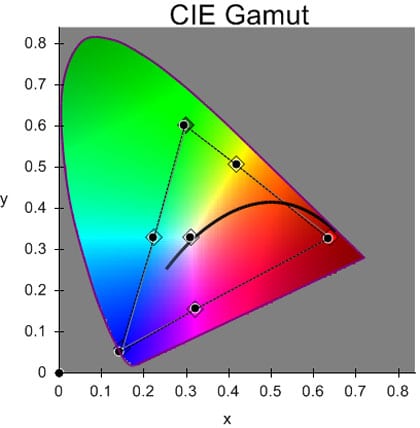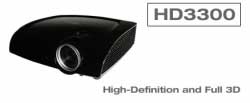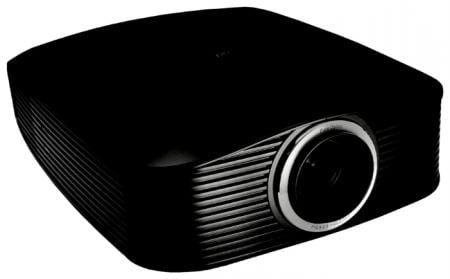This blog starts the discussion on DLP technology for 3D projections. I’ll start with a little history on DLP technology, with a focus on its use for home theater front projectors.
This technology was invented by Texas Instruments (TI) when Dr. Larry Hornbeck of TI demonstrated the first Digital Micromirror Device (DMD) in 1987 (or 24 years ago). The DMD is sometimes also referred to at the "DLP Chip". The DMD is the imaging chip used within every DLP projector. While the underlying technology is now 24 years old the first commercial DLP projector was produced 15 years ago in 1996. The first DLP projector intended for home theater use was sold by DreamVision in 1999 (a standard definition model) and the first home theater DLP projector with a 16 x 9 aspect ratio was introduced by Sharp in 2001. The first full 1080p resolution (i.e., 1920 x 1080) DLP front projectors were introduced in 2006. A more complete history of DLP (including is use for digital cinema) can be found
HERE.
A existing description of DLP projection technology can be found
HERE at Projector Reviews and a somewhat more detailed description
HERE on the dlp.com web site.
Most consumer level DLP projectors use a single DMD imaging chip and a motor driven rotating “Color Wheel”. With this arrangement the color wheel sequentially displays as a minimum, the primary colors (red, blue and green) while the DMD chip displays only the elements of the image that corresponds to the wheel color currently in the light path. Thus the image on the screen is rapidly showing a sequence of single color images and the human eye/brain puts these together to form the desired full color image. The original DLP design displayed each of the primary colors once in each 1/60 second. A reference projector that does this is referred to as having a 1X color wheel. Modern DLP projectors intended for home theater use will have higher speed color wheels, with speeds up to as much as 6X where each primary color is displayed 360 times per second. In some cases a color wheel with 6 segments (e.g., red-blue-green-red-blue-green) is used such that while the actual rotation speed of the color wheel is only 3X, the effective speed is 6X.
It was learned in the early days of DLP projectors that having too slow a color wheel led to viewers seeing what is usually called a “
Rainbow Effect.” This distracting effect may be seen a series of flashes of colors or color fringing when the viewer rapidly moves their eyes or sometimes on certain high contrast video material such as rolling white credits on a black background. Many of the low cost entry-level DLP projectors may still be using relatively slow color wheels while higher priced home theater models frequently use higher speed color wheels to reduce the rainbow effect.
High-end DLP projectors (typically costing over $15K) frequently use 3 DMD chips with one for each of the 3 primary colors (the 3 chip arrangement is similar to the configuration used with all LCoS and LCD projectors). Frequently these 3 chip DLP projectors project a brighter (i.e., higher lumens) image and do not suffer from the rainbow effect of the single chip/colorwheel models.
On the positive side such single DMD chip DLP projectors do not suffer from misconvergence of the primary colors (i.e., misconvergence is a slight misalignment of the red, blue and green primary colors that make up the projected image) as is frequently the case with projectors that use individual imaging chips for each of the 3 primary colors.
Over the years TI has made a number technical changes to the design of the DMDs and currently offers several different versions with different levels of performance. Most home theater oriented DLP front projectors use DMDs of the "Dark Chip" series with DC2, DC3 and DC4 versions being frequently used for such projectors. The top performing DC4 series DMDs are only found in high-end home theater projectors while the lower-end DC2 series is frequently used in entry-level home theater projectors. The biggest difference in the performance of these different series of DMDs relates to their native contrast ratio and the resulting black levels in the projected image. The better projectors using the higher-end DC3 and and especially DC4 series of DMDs frequently have relatively high intra-image contrast ratio (the difference reference white level and reference black level found within the same image) and generally offer better performance in this regard than do most LCoS or LCD based projectors. However LCoS (i.e., DILA) projectors from JVC and the higher end Sony LCoS (i.e,, SXRD) models have a higher native on/off contrast ratio (going from a image at reference white level to a new image at reference black level).
A 3D capability was first introduced in DLP projectors that were targeted at business users and for video gamers. These were generally low-cost 720p class projectors intended for use with a suitably equipped PC as the source of the 3D signal. With these entry-level 3D models the burden was placed on the source device (i.e., PC) to provide a 720p resolution output with a 120 Hz refresh rate, with sequentially alternating right and left images for 3D. The introduction of such “3D ready” 720p DLP projectors pre-dates the more recent industry and broad consumer interest in 3D for the home theater application. Once such broad interest in 3D did mature the Blu-ray Disc Association and the HDMI Organization began industry efforts to develop standards for up to full 1080p resolution 3D recording and for the 3D signal formats respectively. The results were the standards for Blu-ray 3D
TM and for HDMI version 1.4a. These standards focused primarily on 3D home cinema and less so for PC based 3D business graphics or 3D gaming. As a consequence the 3D signal formats defined as mandatory by the HDMI 1.4a standard does not include the 720p 120Hz signal format, which is the only 3D signal format accepted by the early “3D ready” 720p DLP projectors. Earlier this year Optoma introduced an external video processor box that can accept the 3D signal formats defined by the HDMI 1.4a specification and convert them into the 720p 120Hz sequentially alternating 3D format required by these legacy 720p “3D ready” DLP projectors. However, for my following discussions on 3D DLP projectors I will only be discussing the more recently available DLP 3D projectors that have HDMI 1.4a input(s) and will support direct connection to Blu-ray 3D players and other satellite or cable TV 3D sources consistent the HDMI 1.4a required 3D signal formats.
The DLP Advantage for 3D
One of the most frequent complaints when viewing 3D, either in a commercial movie theater or in a home theater environment, is 3D Crosstalk (or 3D Ghosting). This occurs when one eye sees some elements from the image intended for the other eye. Some experiments indicate that if the brightest elements of the alternative image (the unwanted image intended for the other eye) are more than 0.1% as bright as the desired image then some viewers will be able to detect crosstalk on certain scenes. However, most viewers will find 3D displays that are capable of suppressing the alternative images to levels on the order of 0.5% to be reasonably good with 3D crosstalk only occasionally being noticed. With active 3D projection systems crosstalk will generally originate from any of the following 3 sources (assuming the source 3D device provides a crosstalk-free signal into the projector).
1. The display chip within the projector is not able to fully replace all elements of the previous image with the new (i.e., next) image fast enough, thus allowing some traces of the previous image to remain on the display when only the new image should be displayed.
2. The synchronization of the timing between the projector and the 3D active shutter glasses must be very precise otherwise a lens of the glasses may become transparent too early or opaque too late and as a result briefly allow the previous or the next image (i.e., intended for the other eye) to be seen. This timing is complicated as a result of the lenses being used in the active shutter glasses are made from liquid crystals that themselves take some time to fully transition between opaque and transparent states. This transition time typically will be between 0.5 millisecond and 2 millisecond depending on the specific 3D active shutter glasses being used.
3. If the lenses of the 3D active shutter glasses do not become adequately opaque to fully block all visible light that is intended to only be seen by the other eye, then there will be visible 3D crosstalk.
While projectors using LCoS or LCD technology may suffer from 3D crosstalk due to any of the three above sources, DLP projectors inherently do not suffer from item 1 above as the DMDs used with DLP projectors are able to fully transition from one image to the next without the possibility of the any remaining traces from the previous image. Thus if you do see 3D crosstalk with a DLP projector the cause originates from item 2 and/or 3 above (or is present in the source 3D signal).
3D DLP Projectors Models
I intentionally deferred writing this blog on DLP 3D projectors until after the CEDIA Expo in order to be able to more fully report on the DLP 3D projector choices expected to be available this year.
Optoma is the first manufacturer to introduce a DLP 720p 3D projector with full HDMI 1.4a support in the United States. Their new
model GT750 is a successor to the GT720 gaming projector (HDMI 1.3 equipped 3D model). This new model accepts 3D signals in any of the 3D signal formats required by the HDMI 1.4a standard and converts them internally into a 720p 120Hz sequentially alternating video stream for display. Thus when using this projector for 3D video, each eye sees 60 video frames per second. While the GT750 is marketed as a gaming projector, some consumers may select it as an entry-level 3D projector for a budget home theater. However, the performance of this sub-$1000 model gives up a lot as compared to more expensive home theater oriented models in such areas of black levels, contrast ratio, resolution and mounting flexibility. Click on the link above for more information.

Optoma GT750 3D 720p Projector
Now moving on to 1080p 3D DLP projectors specifically being marketed for home theater use. As of now the lowest cost projector of this category is the Optoma HD33 (with a street price of about $1500). This model has been reviewed by Art
HERE on Projector Reviews. While being sold as home theater projector the HD33 perhaps should be considered more of as a step up from the GT750 since, it still offers entry-level performance in terms of black levels, contrast ratio and placement flexibility (i.e., very limited zoom range and no lens shift). However, the HD33 does offer frame interpolation which is frequently only found on more expensive home theater oriented projectors.

Optoma has also introduced a somewhat more expensive model HD3300 as well as a flagship 3D DLP model HD8300. The HD8300 has been reviewed by Art
HERE on Projector Reviews. This higher end model, with a MSRP of $4499, or nearly three times the price of the HD33, offers much better overall performance as it is intended to compete in 2D and 3D video quality against other manufacturer’s projectors with retail prices in the $3K to $5K range.

Optoma HD8300 projector
____________________________________________________
My next blog will continue the discussion of DLP 3D projectors. I will be relocating to my winter home in Florida next week and switching to a new ISP after I arrive there. So my next blog will probably be in about 2 weeks.

 Optoma has also introduced a somewhat more expensive model HD3300 as well as a flagship 3D DLP model HD8300. The HD8300 has been reviewed by Art
Optoma has also introduced a somewhat more expensive model HD3300 as well as a flagship 3D DLP model HD8300. The HD8300 has been reviewed by Art 
